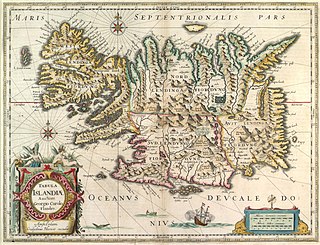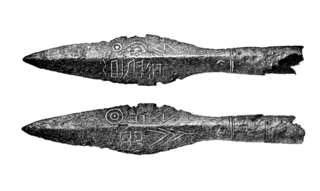Related Research Articles

Freyr, sometimes anglicized as Frey, is a widely attested god in Norse mythology, associated with sacral kingship, virility, peace and prosperity, with sunshine and fair weather, and with good harvest. Freyr, sometimes referred to as Yngvi-Freyr, was especially associated with Sweden and seen as an ancestor of the Swedish royal house. According to Adam of Bremen, Freyr was associated with peace and pleasure, and was represented with a phallic statue in the Temple at Uppsala. According to Snorri Sturluson, Freyr was "the most renowned of the æsir", and was venerated for good harvest and peace.

In Norse mythology, Freyja is a goddess associated with love, beauty, fertility, sex, war, gold, and seiðr. Freyja is the owner of the necklace Brísingamen, rides a chariot pulled by two cats, is accompanied by the boar Hildisvíni, and possesses a cloak of falcon feathers. By her husband Óðr, she is the mother of two daughters, Hnoss and Gersemi. Along with her twin brother Freyr, her father Njörðr, and her mother, she is a member of the Vanir. Stemming from Old Norse Freyja, modern forms of the name include Freya, Freyia, and Freja.

Týr is a god in Germanic mythology. In Norse mythology, from which most surviving narratives about gods among the Germanic peoples stem, Týr sacrifices his hand to the monstrous wolf Fenrir, who bites off his limb while the gods bind the animal, and he is foretold of being consumed by the similarly monstrous dog Garmr during the events of Ragnarök. In wider Germanic mythology, he is known in Old English as Tīw and in Old High German as Ziu, all stemming from the Proto-Germanic theonym *Tīwaz, meaning '(the) God'. Little information about the god survives beyond Old Norse sources. Due to the etymology of the god's name and the shadowy presence of the god in the extant Germanic corpus, some scholars propose that Týr may have once held a more central place among the deities of early Germanic mythology.

Yule or Yuletide is a festival historically observed by the Germanic peoples. Scholars have connected the original celebrations of Yule to the Wild Hunt, the god Odin, and the pagan Anglo-Saxon Mōdraniht.

Gamla Uppsala is a parish and a village outside Uppsala in Sweden. It had 17,973 inhabitants in 2016.

Old Norse Religion, also known as Norse Paganism, is the most common name for a branch of Germanic religion which developed during the Proto-Norse period, when the North Germanic peoples separated into a distinct branch of the Germanic peoples. It was replaced by Christianity during the Christianization of Scandinavia. Scholars reconstruct aspects of North Germanic Religion by historical linguistics, archaeology, toponymy, and records left by North Germanic peoples, such as runic inscriptions in the Younger Futhark, a distinctly North Germanic extension of the runic alphabet. Numerous Old Norse works dated to the 13th century record Norse mythology, a component of North Germanic religion.

Germanic paganism refers to the various religious practices of the Germanic peoples from the Iron Age until Christianisation during the Middle Ages. Religious practices represented an essential element of early Germanic culture. From both archaeological remains and literary sources, it is possible to trace a number of common or closely related beliefs among the Germanic peoples into the Middle Ages, when the last areas in Scandinavia were Christianized. Rooted in Proto-Indo-European religion, Proto-Germanic religion expanded during the Migration Period, yielding extensions such as Old Norse religion among the North Germanic peoples, the paganism practiced amid the continental Germanic peoples, and Anglo-Saxon paganism among the Old English-speaking peoples. The Germanic religion is best documented in 10th- and 11th-century texts from Scandinavia and Iceland.

Stenkil was a King of Sweden who ruled c. 1060 until 1066. He succeeded Emund the Old and became the first king from the House of Stenkil. He is praised as a devout Christian, however with an accommodating stance towards the old Pagan religion. His brief reign saw an armed conflict with Norway.
Inge the Elder was a king of Sweden. In English literature he has also been called Ingold. While scant sources do not allow us to paint a full picture of his term of kingship, he is known to have led a turbulent but at length successful reign of more than two decades. He stands out as a devout Christian who founded the first abbey in Sweden and acted harshly against pagan practices. The kingdom was still an unstable realm based on alliances of noblemen, and Inge's main power base was in Västergötland and Östergötland; one of the earliest chronicles that mention his reign knows him as rex gautorum, king of the Geats.
Norse funerals, or the burial customs of Viking Age North Germanic Norsemen, are known both from archaeology and from historical accounts such as the Icelandic sagas and Old Norse poetry.

Heathenry, also termed Heathenism, contemporary Germanic Paganism, or Germanic Neopaganism, is a modern Pagan religion. Scholars of religious studies classify it as a new religious movement. Developed in Europe during the early 20th century, its practitioners model it on the pre-Christian religions adhered to by the Germanic peoples of the Iron Age and Early Middle Ages. In an attempt to reconstruct these past belief systems, Heathenry uses surviving historical, archaeological, and folkloric evidence as a basis, although approaches to this material vary considerably.
Ingrid Ragnvaldsdotter was born a member of the Swedish royal family, became a member of Danish royalty by marriage and later was Queen consort of Norway as the spouse of Harald IV of Norway. Married four times, Ingrid had a number of children who played prominent roles in Swedish and Norwegian history.

Iceland was Christianized in the year 1000 CE, when Christianity became the religion by law. In Icelandic, this event is known as the kristnitaka.
The Álfablót or the Elven sacrifice is a pagan Scandinavian sacrifice to the elves towards the end of autumn, when the crops had been harvested and the animals were most fat. Unlike the great blóts at Uppsala and Mære, the álfablót was a local celebration at the homesteads that was mainly administered by the lady of the household. Nothing is known about the particular rites because they were surrounded by secrecy and strangers were not welcome to the homesteads during the celebrations. However, since the elves were collective powers with a close connection to ancestors and fertility, it is possible that the álfablót concerned ancestor worship and the life force of the family. It also appears that Odin was implied and that the master of the household was called Ölvir when administering the rites. The first element of Ölvir means "beer", which was an important element in Norse pagan sacrifices generally.
Eric Clauesson was a Swedish man executed for sorcery, theft and heresy, though in reality he was executed for his paganism. His case illustrates the survival of the pre-Christian pagan Norse religion in Sweden as late as in the 15th century.

The Odinist Community of Spain – Ásatrú, also known as European Odinist Circle, is a Germanic neopagan organisation in Spain, founded in 1981, for followers of the denomination of modern heathenism known as Odinism, and is also accepting of broader Ásatrú and Vanatrú neo-heathenism. The community bases its ideology on the Visigothic, Suevian and Vandalian Germanic heritage of modern Spain, Portugal and Occitania, dating to the 6th century. It was legally recognised as a religious institution by the Spanish government in 2007, and performed the first legal pagan wedding in mainland Spain since the Visigothic era, in Barcelona on 23 December 2007. In Albacete in 2009, COE completed the first temple to Odin believed to have been built in over 1,000 years. A less Odin-focused group split off in 2012 as the Ásatrú Lore Vanatrú Assembly (ALVA).

Odin is a widely revered god in Germanic mythology. Norse mythology, the source of most surviving information about him, associates Odin with wisdom, healing, death, royalty, the gallows, knowledge, war, battle, victory, sorcery, poetry, frenzy, and the runic alphabet, and projects him as the husband of the goddess Frigg. In wider Germanic mythology and paganism, the god was known in Old English and Old Saxon as Wōden, in Old Dutch as Wuodan, and in Old High German as Wuotan, all ultimately stemming from the Proto-Germanic theonym *Wōđanaz, meaning 'lord of frenzy', or 'leader of the possessed'.
Norse religious worship is the traditional religious rituals practiced by Norse pagans in Scandinavia in pre-Christian times. Norse religion was a folk religion, and its main purpose was the survival and regeneration of society. Therefore, the faith was decentralized and tied to the village and the family, although evidence exists of great national religious festivals. The leaders managed the faith on behalf of society; on a local level, the leader would have been the head of the family, and nationwide, the leader was the king. Pre-Christian Scandinavians had no word for religion in a modern sense. The closest counterpart is the word sidr, meaning custom. This meant that Christianity, during the conversion period, was referred to as nýr sidr while paganism was called forn sidr. The center of gravity of pre-Christian religion lay in religious practice — sacred acts, rituals and worship of the gods.

Norse mythology is the body of myths of the North Germanic peoples, stemming from Norse paganism and continuing after the Christianization of Scandinavia, and into the Scandinavian folklore of the modern period. The northernmost extension of Germanic mythology, Norse mythology consists of tales of various deities, beings, and heroes derived from numerous sources from both before and after the pagan period, including medieval manuscripts, archaeological representations, and folk tradition.

Gothic religion was the original religion of the Goths before their conversion to Christianity.
References
- Christer Öhman (1994). Helgon, bönder och krigare. Berättelser ur den svenska historien.. Värnamo: Fälths. ISBN 91-518-2667-4
- Henrik Schück (1940). Stockholm i slutet av 1400-talet.. Stockholm. ISBN 99-0277315-X